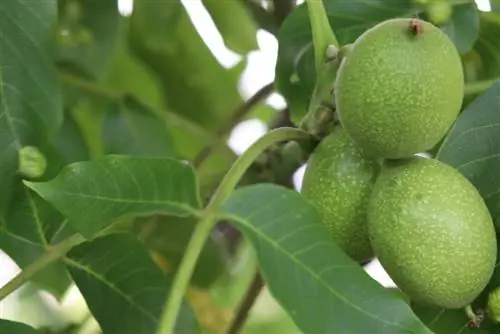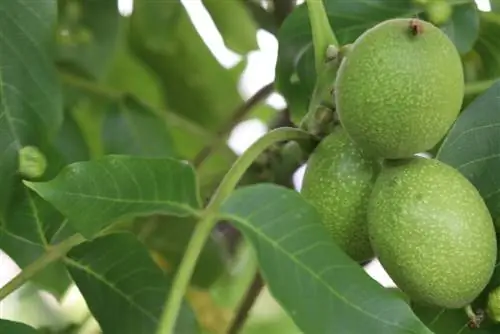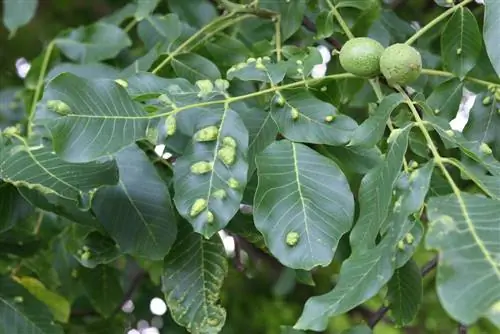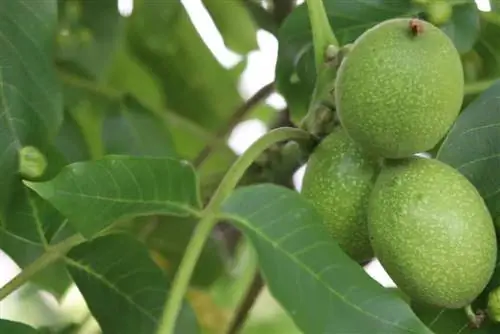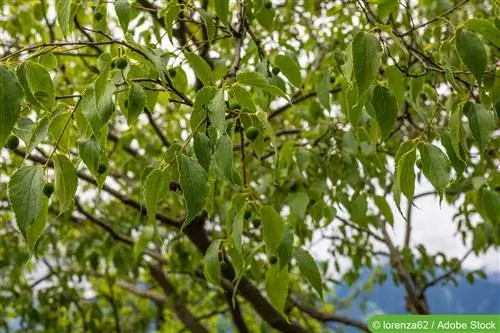- Author admin [email protected].
- Public 2023-12-17 03:39.
- Last modified 2025-01-24 12:45.
A large garden with lots of sunlight and light is ideal for cultivating an impressive walnut tree. Since it needs a lot of sunlight, when it is fully grown it can also be a wonderful source of shade in the middle of a large lawn. In addition, the Juglans regia enchants with its decorative flower dress in summer before the tasty fruits can be harvested in autumn. A fully grown walnut tree in a large garden offers many advantages with little maintenance required.
Profile
- grows up to 15 meters high
- grows in height, width and depth
- reaches full size after about 60 years
- Fruit is not a “nut” but a drupe
- the pulp is not edible
- only the stone can be eaten
- this corresponds to the cherry stone
- decorative and lush flowering in April/May
- Leaves exude a spicy and bitter scent
- young tree must be protected from frost in winter
Location
Since the walnut tree can reach an impressive height of up to 15 meters or higher and also grows very wide, it needs a location that can also offer it this space in later years. The tree prefers it to be free and airy, because if it is pressured by other plants or house walls, in the worst case scenario it will stop growing. Therefore, the decorative tree is not suitable for small gardens. Ideally, it will be given a place in a large meadow, without any other trees nearby, because here it can develop unhindered. Otherwise the location should have the following characteristics:
- sunny and bright
- no shadows
- enough space for neighbors
- certain minimum distances must be maintained here
- these are required by law
- consider this when choosing a location for a small tree
Tip:
The walnut tree will not develop properly if it is located in the shade. Therefore, it definitely needs a location with lots of light. This applies especially to the small, young specimens.
Substrate & Soil

The walnut does not place any great demands on the soil; normal garden soil is completely sufficient here. Otherwise, the soil should be nutrient-rich and permeable because the roots must be able to expand unhindered. Therefore, the substrate at the site should be prepared as follows:
- enrich with compost
- Peat can also be mixed in
- Horn shavings are also recommended
- must be carried out especially on loamy garden soil
- so the earth becomes looser and more permeable
- always keep slightly moist
- Avoid waterlogging
Watering & Fertilizing
The young walnut tree in particular must not dry out. Care should always be taken to ensure there is enough water. Since it prefers a location in full sun, the soil dries out quickly. Therefore, watering must be carried out, especially during very hot and dry periods. Otherwise, natural rainfall is sufficient. Even in winter, the young plant needs to be watered regularly on frost-free days if there is a long period of dry cold. Mulch can also be placed here so that the soil around the tree does not dry out. When fertilizing, the following should be taken into account:
- the young walnut tree in particular needs a lot of nutrients
- so he can develop more splendidly
- therefore fertilize regularly
- long-term fertilizer such as blue grain can also be used here
Tip:
The adult tree usually only needs little to no fertilizer since no other plants can settle under its crown, which is due to the falling leaves. This is not tolerated well by other plants.
Plants
Once the right location has been chosen for the walnut tree, it can be planted. The walnuts are available in garden centers or tree nurseries as containers or bales. The tree delivered in the container is carefully removed from the pot; in the case of bales, the cloth or net wrapped around the roots is cut open. This does not have to be removed, it can be planted. The natural materials decompose in the soil over time. When planting, the following should also be taken into account:
- planted in spring after the Ice Saints
- so the new tree can grow well over the summer
- Place root ball in a container with water
- dig the hole
- create drainage from stones or pottery shards to prevent waterlogging
- Insert the tree, roots should just line up with the ground above
- insert a rod for stabilization
- fill in prepared soil, press lightly
- pour well
- water a lot in the first few weeks after planting
Tip:
If a small, young walnut tree was purchased, it can be transplanted about every two years for the first few years. This stimulates the growth of the roots and the tree becomes more stable. An older tree no longer needs this procedure; the roots are already strengthened to the point where they can supply the tree with everything it needs.
Cutting
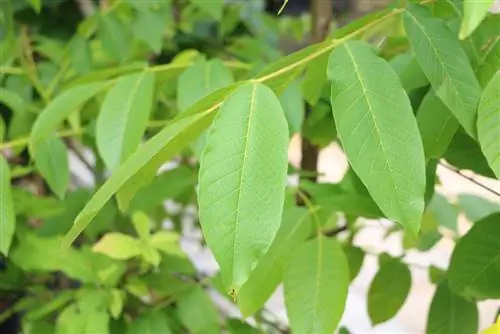
When young, the walnut should be cut regularly. This makes the trunk stable and the branches of the crown woody well. This way it is better protected from dry summers and cold winters. However, it is usually the case that the trees are not cut in the wild and the natural growth should be maintained in your own garden. Therefore, when cutting the tree cultivated in the garden, you should proceed as follows:
- the main cut takes place in autumn
- During this time you can also cut into old wood
- completely remove thick branches that prevent new shoots from growing
- close large wounds with tree wax
- the crown can be cut as a whole if you don't want the tree to get any taller
- in such a case it grows in width
- Summer should be chosen for a topiary
- The shape can be better recognized thanks to the existing leaves
- never cut on rainy days, it promotes fungal diseases
- older, adult trees do not require pruning
Tip:
Always wear gardening gloves when cutting. Just like the pulp of the fruit, the leaves and bark of the walnut tree also stain heavily.
Propagate
A walnut tree can easily be propagated by cuttings. If you already have a walnut in your garden, things are easy here. But the shoots required for this can also be taken from a free-standing tree, as these are not protected. To propagate the decorative tree, proceed as follows:
- Use shoots about 15 centimeters long
- Place directly into a pot with potting soil
- spend in a bright and warm place
- Keep soil well moist
- new leaves will sprout after about 14 to 20 days
- this is the sign of the growth of the cutting
- then it can be planted at its location
- wait for the time after the Ice Saints
Tip:
It is better to leave the cutting taken in summer in the pot over the first winter and to overwinter it in a bright, not too warm but frost-free place and only plant it in the selected location the next spring after the Ice Saints.
Propagate through the fruit
The Juglans regia can also be propagated through the fruit. To do this, the core is removed from the pulp and placed in a pot filled with growing soil. Gardening gloves should definitely be worn for this work, as the pulp gives off a brown to black color that was previously used for coloring. The gloves can protect your hands from unsightly discoloration. Furthermore, this method of propagation should proceed as follows:
- Place the pot in a bright and warm location
- Keep soil well moist
- put on a windowsill in winter
- The first small shoots appear in spring
- when these are about 15 cm high, they can be planted outdoors
- but not in front of the Ice Saints
With this process, however, there is a risk that the newly obtained walnut trees will not produce any yield because they have not been refined. However, this danger does not exist when propagated from shoots using cuttings.
Tip:
If you cultivate a walnut tree in your garden, you will find that it can sit in its pleasant shade without being plagued by annoying mosquitoes and other insects. This is due to the scent of the leaves, which is pleasant for humans but very unpleasant for insects.
Wintering
The young walnut is only partially frost hardy and should therefore be protected in winter for the first few years. The cold in these latitudes no longer bothers an adult tree. But precisely because a location has already been chosen for what will later become a large and sprawling tree, the young walnut tree is left quite unprotected in winter. Therefore, winter protection for the young tree should look like this:
- Roots and trunk must be protected
- so put mulch or brushwood on the ground
- Jute mats can be wrapped around the trunk
- also protect the crown in very cold, frosty winters
- cover this with garden fleece
Care errors, diseases or pests
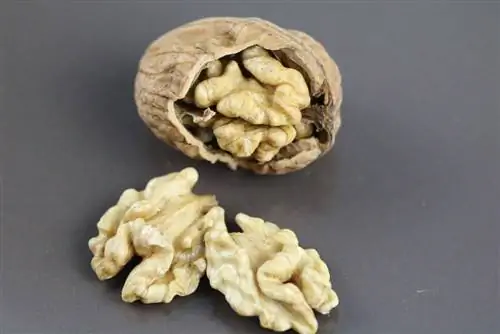
Unfortunately, the walnut tree is known to have diseases and pests that can cause great harm to the tree, and not just when it is young. In addition, care errors can quickly occur on the young trees. The first thing to mention here is watering that is too sparing, as a young tree runs the risk of drying out. In addition, frost can affect it in winter if it is not adequately protected. The diseases and pests that could be harmful to Juglans regia at any age are mainly:
- Caterpillars and aphids
- these eat or suck the leaves
- If an infestation is detected, take immediate action with insecticides
- otherwise the tree will be weakened too much
- fungal diseases can also affect the walnut
- use fungicides against this
- young trees often suffer from bacterial blight
- This is shown by weeping black spots
- these can be seen on shoots, leaves and nuts
- in such a case, return the newly purchased tree to the dealer
Small rodents also like to eat the roots. If a tree shows signs of drying out even though it has been watered sufficiently, you should check the roots to see whether they have been eaten. If this is the case, rodent traps must be used to save and protect the tree.
Tip:
The hobby gardener can protect his trees and shrubs against root damage by rodents with so-called rodent or vole protection. These are wire baskets that are placed around the roots when planting. For a walnut tree that has very extensive roots, a particularly large size must be used.
Conclusion
If you buy a walnut tree for your large garden, you have to invest a little more time in caring for it in the first few years. The young tree needs a lot of water, regular pruning and winter protection. Once Juglans regia has developed into a stately tree, the hobby gardener hardly has to do any maintenance. The tree then offers a cozy place in the shade from spring to autumn, a decorative sea of flowers in summer and tasty fruits in autumn.


